- an a$achment-based developmental approach - in children and adolescents
Gordon Neufeld, Ph.D. Clinical & Developmental Psychologist
Vancouver, Canada
A JACK HIROSE SEMINAR
Calgary, Alberta May 9, 2024
Copyright 2024 Gordon Neufeld, Ph.D. All rights reserved.
The handout is intended for registered par?cipants of this seminar only.
Please do notduplicate this document without permission.For more informa?on regarding the Neufeld Ins?tute or Dr. Neufeld and his work, please consult the website.
www. neufeldins8tute.org
ANXIETY addressing the root causes of
addressing the root causes of
ANXIETY
in children and adolescents
- an a%achment-based developmental approach -
Gordon Neufeld, Ph.D Developmental & Clinical Psychologist Vancouver,
Canada


ANXIETY
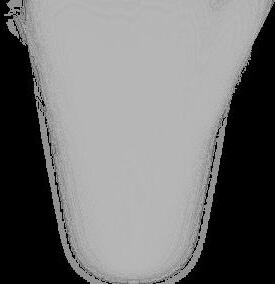

What is anxiety?
… a vague sense of unsafety and unease, characterized by apprehension and restlessness
… one’s subjective experience of an activated ALARM system
ANXIETY - Gordon Neufeld Hirose Seminars - Calgary - May 9, 2024
1
Copyright 2024 Gordon Neufeld PhD
• headquartered in the emoJonal or LIMBIC SYSTEM of the brain
• mediated by the SYMPATHETIC branch of the autonomic nervous system

• has high priority in funcJoning, affecJng AROUSAL and hijacking ATTENTION
alarm system
• acJvates the ENDOCRINE and IMMUNE systems and affects most every system
• mediated through special NEUROTRANSMITTERS in the nervous system
• begins operaJng in the FETUS at about six months aRer concepJon
ATTACHMENT is our preeminent need so SEPARATION is our greatest threat
• aTachment is about the drive towards TOGETHERNESS in all its various forms
• the primary purpose of aTachment is move us to take CARE of each other – a"achment replaces survival in mammals
• aTachment is powerful, primal, primordial and PREEMINENT – the first of three basic drives (play and achievement)
• triggered by where aTached facing separation
• it follows that facing separaJon is our greatest threat and the essence of STRESS

• alarm is one of three primal emoJons evoked to aTempt an instant FIX to the separaJon problem (the other two being frustra2on and separa2on-triggered pursuit)
• the NATURE of the separaJon faced is directly derived from the nature of one’s aTachments facing separation can’t be with ... not special to ... notunderstoodby... BETRAYED NOT LIKED BY ... feelingunlovedby... replacedby... isolation rejecJon not wanted discounted by ... lack of belonging can’tconnectwith... can’t hold on when apart feelingdifferent losing face not important to ... not recognized by ... threats to identity

NEGLECTED NOT HELD ON TO BY ... being alone not belonging not maTering to ...
ANXIETY - Gordon Neufeld Hirose Seminars - Calgary - May 9, 2024 Copyright 2024 Gordon Neufeld PhD 2
• alarm is a PRIMAL emoJon that can exist without any awareness or cogniJve input or involvement
• is meant to take care of us by moving us to CAUTION
• once acJvated, alarm seeks RESOLUTION in one way or another. Failure to resolve alarm results in RESIDUAL alarm

• alarm and its effect may or may not be FELT, or be felt in different ways
• when felt, has a significant TEMPERING effect on behaviour
• is oRen PROVOKED by adults as a way of managing behaviour alarm emotion as an
• alarm can DISPLACE other emoJons as drivers of behaviour when more intense
• alarm is a very VULNERABLE emoJon to feel as it brings us face to face with what threatens us
• triggered by where aTached
• headquartered in the emoJonal or LIMBIC SYSTEM of the brain
• mediated by the SYMPATHETIC branch of the autonomic nervous system

• has high priority in funcJoning, affecJng AROUSAL and hijacking ATTENTION
• acJvates the ENDOCRINE and IMMUNE systems and affects most every system
• mediated through special NEUROTRANSMITTERS in the nervous system
• begins operaJng in the FETUS at about six months aRer concepJon
• both the separaJon and alarm must be for the alarm system to funcJon properly
ABOUT FEELINGS AND ALARM
1. One can BE alarmed without FEELING alarmed. - just as one can BE sick, hurt, hungry, 2red, frustrated, angry, a"ached, in love, pregnant – without feeling it at any given moment or even at all for that ma"er
2. We only FEEL alarmed if the cogniJve brain receives the feedback coming back into the brain from the body, and interprets it as alarm. - this feedback does NOT have high priority for processing, is LESS likely when the brain is under stress or has other work to do, must be TIMELY for the links to be made, and can be defensively INHIBITED
3. The more directly one FEELS the alarm as separaFon alarm, the more likely the links will be made, sebng the stage for alarm to be resolved.
4. Alarm can ALSO be felt vaguely as anxiety (unsafe, uneasy, apprehensive), indirectly as agitaFon or restlessness (the arousal system) or energeJcally as an adrenalin rush
ANXIETY - Gordon Neufeld Hirose Seminars - Calgary - May 9, 2024 Copyright 2024 Gordon Neufeld PhD 3
alarming separa2on must be correctly FELT for cau2on to be effec2ve



the fu2lity of avoiding alarming separa2on must be FELT for adapta2on to occur


ALARMING SEPARATION WHERE AVOIDANCE IS FUTILE
• bedJme, loss and mortality
• separaJon resulJng from going to school, moving, divorce of parents, parents working, hospitalizaJon, etc, etc
• the dawning realizaJon of the inevitability of loss and losing
• always being wanted, chosen and preferred by those whom we want, choose or prefer
• being liked by everyone or avoiding rejecJon


• the lack of invitaJon to exist in another’s presence
• the loss of affecJon or significance to another
• securing the contact and closeness in an aTachment
To a"ach is to face separa2on, but we must a"ach and so facing separa2on cannot ever be truly avoided
Adapting to Alarming Separation that Cannot be Avoided


• RESOLVES alarm, providing some REST and RELIEF from the primal emoJon



• develops the RESILIENCE to handle a world full of separaJon alarm
• enables RECOVERY from alarming events and alarming aTachments
ANXIETY - Gordon Neufeld Hirose Seminars - Calgary - May 9, 2024 Copyright 2024 Gordon Neufeld PhD 4
alarming separa2on must be correctly FELT for cau2on to be effec2ve


inner conflict must be FELT for alarm to be tempered

the fu2lity of avoiding alarming separa2on must be FELT for adapta2on to occur




ALARM DESIRE
to engage in an activity to be away from home to take part in some fun to be laughed at to ask one’s question to appear stupid to stand up for a friend to lose popularity
ALARM & DESIRE
to pursue a passion
to be oneself



to have to let go to get attached & involved to wear what one prefers to be seen as different to share one’s story to not be interesting to meet disapproval to express one’s opinion



to not measure up
to be alone
The capacity for COURAGE is developed through feeling conflicted
• the capacity for registering more than one feeling at a Jme begins to develop between 5 to 7 YEARS of age. The more intense the feelings, the longer it takes.
• the development of the prefrontal cortex is SPONTANEOUS but not inevitable – child must first be full of feelings and then court the inner conflict

• the prefrontal cortex takes years to become fully funcJonal. The capacity for consideraJon has a LENGTHY gestaJon period.
• the primary reason for the failure to develop a working prefrontal cortex (and thus the capacity to consider) is a LACK of tender feelings
• feelings of CARING & ALARM are the primary source or cause of inner conflict, dissonance or fricJon
ANXIETY - Gordon Neufeld Hirose Seminars - Calgary - May 9, 2024 Copyright 2024 Gordon Neufeld PhD 5
TRAITS DERIVED FROM A WELL-FUNCTIONING ALARM SYSTEM
• CAREFUL
• CAUTIOUS
• CONCERNED
• CONSCIENTIOUS
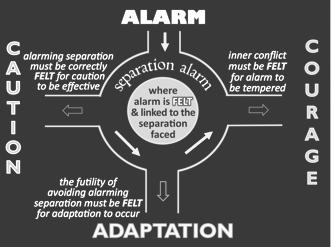
• REFLECTIVE
• characterized by a conflicted RELATIONSHIP with alarm
• RESOLUTE –not controlled by alarm
• RESTFUL (from finding RELIEF & RESOLUTION re alarm)
• RESILIENT (from having RECOVERED from alarming events and having adapted to an alarm-filled life)
A funcJoning alarm system should move us …
… to CAUTION if that is possible
… to ‘CRY’ if that is fuJle
… to take COURAGE if what alarms is in the way
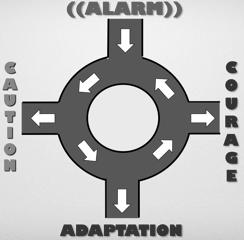
addressing the root causes of in children and adolescents
PART II
ANXIETY as part of a conQnuum of ALARM-BASED PROBLEMS caused by the failure to feel sufficiently
ANXIETY - Gordon Neufeld Hirose Seminars - Calgary - May 9, 2024 Copyright 2024 Gordon Neufeld PhD 6
ANXIETY
cau2on that does exist is misplaced & thus ineffec2ve, OR not moved to cau2on at all m i s


WHEN FEELINGS ARE LACKING
the fu2lity of avoiding the alarming separa2on is NOT felt
inner conflict is NOT felt and so avoidance impulses are not tempered




LEVEL 1 – ANXIETY PROBLEMS
- FLIGHT from alarming things and situaFons – involves obsessions and compulsions, which can include phobias and paranoia, as well as a preoccupaJon with staying out of trouble
LEVEL 2 – AGITATION & ATTENTION PROBLEMS
- FLIGHT from apprehension and a%ending to what alarms - results in significant aTenJon deficits, not being able to stay out of trouble, not being moved to cauJon, recklessness and carelessness
LEVEL 3 – ADRENALIN SEEKING PROBLEMS
- FLIGHT from any sense of vulnerability whatsoever – the adrenalin rush involved in doing alarming things when devoid of a sense of vulnerability results in being aTracted to what alarms and a predisposiJon for being a trouble-maker
The Continuum of ALARM Problems
alarm is displaced


ANXIETY problems (obsessions & compulsions)
felt vaguely as unsafe, uneasy or apprehensive
alarm is dysfunc2onal

AGITATION, ATTENTION, & DISCIPLINE problems
alarm is perverted
ADRENALIN SEEKING problems
felt indirectly as agitaFon or restlessness but lacking apprehension
felt only as adrenalin and lacking other vulnerable feelings

ANXIETY - Gordon Neufeld Hirose Seminars - Calgary - May 9, 2024 Copyright 2024 Gordon Neufeld PhD 7
l a c e d
p
• •
• • • • • • • • • •
HIGHLY ALARMED
The Continuum of ALARM Problems
alarm is displaced


ANXIETY problems (obsessions & compulsions)
felt vaguely as unsafe, uneasy or apprehensive
alarm is dysfunc2onal

alarm is perverted
AGITATION, ATTENTION, & DISCIPLINE problems
felt indirectly as agitaFon or restlessness but lacking apprehension
ADRENALIN SEEKING problems

ANXIETY - based
felt only as adrenalin and lacking other vulnerable feelings
AlarmedbutDefendedAgainstit
A Continuum of Defendedeness
The defensive inhibiJon of feelings is sufficient enough to interfere with linking the feelings of alarm to the separaJon faced, but NOT enough to keep from feeling nervous. The result is anxiety
AGITATION - based
The defensive inhibiJon of feelings is significant enough to keep from feeling nervous but NOT enough to keep from feeling agitated or restless. In addiJon, defensiveness in aTenJon results in a blindness to that which truly alarms. The result is agitaFon without apprehension plus significant deficits in a%enFon.
ADRENALIN -based

The defensive inhibiJon of feelings is severe enough to keep from feeling nervous, agitated or vulnerable, resulJng in feeling ONLY the chemistry of alarm. The result is being a%racted to what alarms
What is anxiety?

… a vague sense of unsafety and unease, characterized by apprehension and restlessness
… one’s subjective experience of an activated ALARM system
… a response to facing separation where the FEELINGS that link the alarm with the separation faced are missing
… a state of alarm-driven AVOIDANCE characterized by a FLIGHT from what our thinking brain has mistakenly assumed is the reason for alarm
ANXIETY - Gordon Neufeld Hirose Seminars - Calgary - May 9, 2024 Copyright 2024 Gordon Neufeld PhD 8
• • HIGHLY ALARMED • • • • • • • • • •
CAUTION is SKEWED or MISPLACED








ALARM IS VAGUELY FELT AND FALSELY ATTRIBUTED




UNTEMPERED – inner conflict is NOT felt




... the MISTAKEN SOURCES OF ALARM
TRAITS DERIVED FROM AN ANXIETY-BASED ALARM PROBLEM
• obsessive
• compulsive
• overly cauJous & conscienJous

• can be impulsive & reacJve
• lacking a relaJonship with alarm
• beliefs do not calm alarm
• not given to sadness or grieving (especially around the alarming separaJons that were or are unavoidable )
SYMPTOMS OF PRIMAL EMOTION

COGNITIONBASED DERIVATIVES OF PRIMAL EMOTION

PRIMAL EMOTION

TRIGGERING EXPERIENCE

COMPULSIONS worry FEAR tension panic self-doubt idenQty confusion restless AGITATION NERVOUS paranoia unease ANXIETY phobias

OBSESSIONS
mistaken assumpJons regarding what’s wrong
ALARM triggered by facing separation


ANXIETY - Gordon Neufeld Hirose Seminars - Calgary - May 9, 2024 Copyright 2024 Gordon Neufeld PhD 9
IRRATIONAL OBSESSIONS

(mistakes regarding ‘what’s wrong’)
• someone or something is out to hurt me or to get me
• something is wrong with my health or my functioning or is going to make me sick
• something is out of order or out of place
• something is wrong with my body or with how I look
• some places or situations are dangerous or unsafe
• something has been left undone
• one is ‘too much’ or ‘not enough’







RESULTING COMPULSIONS
(to avoid or reduce alarm)
work at avoiding the monsters and scary creatures, avoid getting conned, uncover people’s plots work at keeping things clean, at not getting sick, at avoiding germs, at avoiding contamination work at putting things in order and their place work at improving one’s appearance or at changing one’s shape work at avoiding that which makes one feel unsafe (ie, phobias)
work at remembering to complete one’s tasks
work at editing or enhancing, diminishing or improving oneself
ACTIONS & ACTIVITIES THAT PROVIDE MOMENTARY RELIEF - can develop into compulsions or addicFons -



• triggering parasympatheQc acQon (eg, sucking, eaJng, chewing, nail-biJng, masturbaJon [boys], physical exerJon, controlled breathing)

proximity fixes (stroking, hugging, transiJonal objects, contact comfort)











rhythmic acQvity and pa]erning (rocking, pacing, rhythmic beat, drumming, swinging, worry beads, flickering fire, watching waves, hand wringing, etc )

• drug-taking – depressants (eg - alcohol for alarm, marijuana for agitaJon, myriad of anJ-anxiety drugs & medicaJons)

• drug-taking – sQmulants to evoke a return swing of the pendulum – caffeine, nicoJne, Ritalin, etc


• emoQonal playgrounds where alarm is de-acJvated – eg, music, drama, art, dance, movement, stories, silliness, humour, games, cultural rituals
CARELESS and RECKLESS – NOT moved to cauFon











UNTEMPERED – inner conflict is NOT felt
ALARM NOT FELT DIRECTLY







... ATTENDING TO WHAT TRULY ALARMS
ANXIETY - Gordon Neufeld Hirose Seminars - Calgary - May 9, 2024 Copyright 2024 Gordon Neufeld PhD 10
TRAITS DERIVED FROM AN AGITATION-BASED ALARM PROBLEM
• restless, tense or hyperacJve
• predisposed to agitaJon reducJon &/or expression (eg, drugs, physical exerJon, freneJc acJviJes or sJmulaJon)
• lacking apprehension
• can’t stay out of trouble or harm’s way
• overly gregarious & talkaJve

• doesn’t learn from mistakes and failure • predisposed to learning disabiliJes
stuck in the iniJal either-or mode of aTenJon instead of progressing to the advanced this-and mode

a%achment - based

not properly aTached to, or engaged by, those aTempJng to command aTenJon
• impulsive & reacJve
• aTenJon deficits where alarmed
• lack of memory for alarming events
• scaTered aTenJon where alarmed
COMMON ATTENTION PROBLEMS immaturity -based


hypersensiFvity -based
signal overload due to dysfuncJonal aTenJonal filters
ALARM-based
A]enQon is hijacked by alarm, creaQng significant deficits and concentraQon problems. A]enQon is sca]ered because of compeQng biases – to a]end to what alarms and avoid looking at what alarms.
about alarm-based a"en2on problems
• key signs are ‘highly agitated’ as IF highly alarmed but ‘without apprehension’ as if not at all alarmed
• aTenJon system receives mixed messages from the brain: pay a"en2on to what alarms and don’t look at what alarms
• the two primary symptoms are sca%ered a%enFon and significant a%enFonal deficits around alarming situaJons (eg, can’t see trouble coming, can’t stay out of harm’s way, more gregarious than would be appropriate, somewhat reckless and careless, poor memory for alarming situaJons)
• typically will qualify for an a%enFon deficit diagnosis as the syndrome meets the three criteria: difficulty concentraJng, restlessness or agitaJon, and impulsiveness (only two of the three are required for the diagnosis)
ANXIETY - Gordon Neufeld Hirose Seminars - Calgary - May 9, 2024 Copyright 2024 Gordon Neufeld PhD 11
a%racted to, & engaged by, WHAT ALARMS










ALARM, AGITATION & VULNERABILITY NOT FELT








UNTEMPERED – inner conflict is NOT felt ... ALL VULNERABLE FEELINGS
TRAITS DERIVED FROM AN ADRENALIN-BASED ALARM PROBLEM
• does alarming things (eg, risk-taking, cubng, burning)
• seems relaJvely unaffected by what should alarm
• FEARLESS
• risk-taking
• can become a troublemaker
• can lack a conscience
• more able to engage in ‘cold’ cauJon
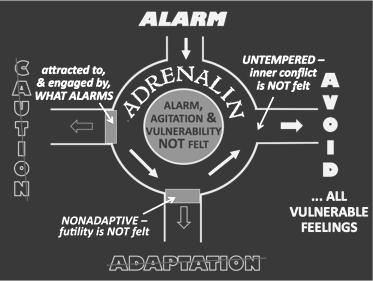
• unreflecJve
• unconflicted
• inconsiderate
• unfeeling
• TEARLESS – lacking in sadness and devoid of grief
• adversity hardens rather than soRens
Some aTracJons of the highly defended …
• scary rides and horror movies
• breaking taboos and out-of-bound behaviour
• dangerous acQviQes
• daredevil stunts
• delinquent acQvity and being ‘bad’
• extreme sports
• cucng and burning
ANXIETY - Gordon Neufeld Hirose Seminars - Calgary - May 9, 2024 Copyright 2024 Gordon Neufeld PhD 12
nervous
does alarming things
OBSESSIONS compulsions
panic
ATTRACTED TO WHAT ALARMS
can’t stay out of trouble AGITATION
over- conscienQous
ANXIETY
reckless & careless
worry

unable to stay out of harm’s way SCATTERED ATTENTION concentraFon problems lacking curiosity

facing separation
FEARLESS
tension RESTLESSNESS
ADRENALIN- SEEKING
cucng & burning hair-pulling
Qcs stu%ering
unease phobias
ANXIETY
addressing the root causes of in children and adolescents
PART III
A closer examinaQon of the ROOT CAUSES of ESCALATING ALARM in our children and youth
WHY TODAY’S CHILDREN ARE MORE ALARMED and less able to deal with it
• premature separaJon
• failure to develop the capacity for relaJonship
• peer orientaJon
FACING MORE SEPARATION


LOSING THEIR FEELINGS
ANXIETY - Gordon Neufeld Hirose Seminars - Calgary - May 9, 2024
13
Copyright 2024 Gordon Neufeld PhD
BECOMING MORE ALPHA
• the sense of connecJon or togetherness needs to be relaJvely conJnuous for development to unfold
premature separaQon = physical separa2on before a child has developed more mature rela2onship-based ways of holding on when apart • today’s children typically experience being apart from the adults they are aTached to, both earlier and longer than in previous generaJons
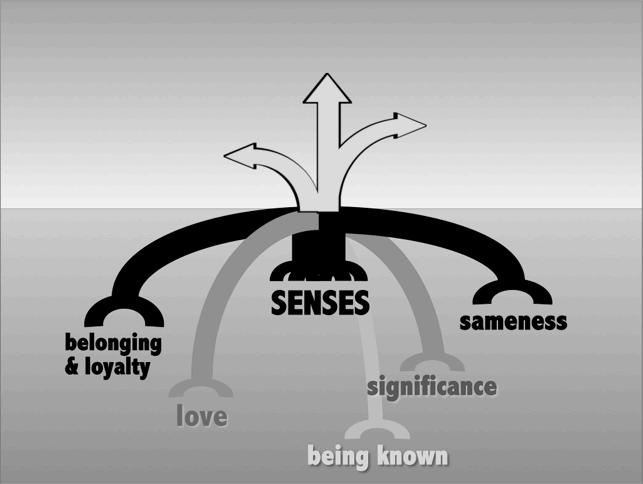
TODAY’S CHILDREN FACE MORE SEPARATION
1) more likely to be APART from their parents for reasons of divorce, schooling, parental employment, out-of-home care, aRer-school acJviJes, and digital preoccupaJons
2) when apart from their parents, NOT as likely to be ATTACHED to the ADULTS responsible for them (contribu2ng factors include smaller nuclear families, loss of extended families, loss of the village of a"achment, gradual driGing of school outside the a"achment village, loss of culture that would foster the needed child-adult a"achments, lack of focus on student-teacher rela2onships)
3) more likely to become PEER ORIENTED as a result of falling through the aTachment cracks of today’s society
PEER ORIENTATION

Children taking their cues from each other as to how to act, what to do, how to talk, what to wear, how to express oneself, what is valued, what is expected, what is right and what is wrong
The compeQng nature of most peer a]achments today (ie, can’t be close to both peers and adults simultaneously) pulls children out of orbit from around the adults responsible for them
ANXIETY - Gordon Neufeld Hirose Seminars - Calgary - May 9, 2024 Copyright 2024 Gordon Neufeld PhD 14
PEER ORIENTATION FUELS ALARM
• peer aTachments are inherently INSECURE – the more one’s peers maTer, the more separaJon is being faced by default
• robs adults of the power they need to keep social interacJon safe
• powerless adults, in turn, resort to alarmbased methods of behaviour management, fueling alarm further

• the peer-oriented can be cruel and uncaring to those outside their ‘tribe’, fueling alarm


• peer orientaJon robs children of the shielding and protecJon they need to live in an alarming world
• drives alarm under- ground as fearlessness is venerated by the peer-oriented and any show of alarm can be shamed or exploited
• the peer oriented are drawn to social media where alarming interacJon is the norm
• peer orientaJon breeds ALPHA children, fueling alarm even further
WHY TODAY’S CHILDREN ARE MORE ALARMED and less able to deal with it
• premature separaJon
• failure to develop the capacity for relaJonship
• peer orientaJon
FACING MORE SEPARATION



BECOMING MORE ALPHA
LOSING THEIR FEELINGS
• failure of adults to inspire dependence
• not safe to depend
• peer orientaJon
Common ManifestaQons of ALPHA Children
• predisposed to take charge, to take over, to take the lead
• inclined to command aTenJon, to take centre stage
• moved to talk louder, to talk over, to talk for another
• tend to demand deference, to give orders, to take command




• compelled to be first, to be the best, to be on the top
• insist on being the one to give direcJons and define the meanings
• compelled to trump interacJon, to have the last word
• oRen need to be in the know, to be the most knowledgeable
ANXIETY - Gordon Neufeld Hirose Seminars - Calgary - May 9, 2024 Copyright 2024 Gordon Neufeld PhD 15
EscalaQng Cycle of ALPHA and ALARM
ALARMED CHILDREN BECOME MORE ALPHA
- alarming events can trigger alpha as defense as the adults they depended upon could not keep them safe. The resulJng alpha locks them into alarm.



ALPHA CHILDREN BECOME MORE ALARMED

- a lack of dependent trusJng relaJonship robs them of a place of refuge, safety and shielding in an alarming world
- alpha children are difficult to ‘hold’ in an experience of fuJlity, blocking adaptaJon to an alarming world

ALPHA CHILDREN ALARM OTHERS
- general alarm is increased as alpha children who are defended against alarm take pleasure in asserJng their dominance by triggering alarm in others through threats and inJmidaJon
Why Today’s Children are Becoming More ALPHA
• is a natural response to stress (ie, facing more separaJon)
• today’s parents and teachers are more childled, pubng the child in the alpha role by default
• dependence is not as likely to be invited by today’s parents and teachers




• today’s parents and teachers seem to have more difficulty assuming an alpha posture, resulJng in children filling that void
‘you won’t be able to stay with us if you don’t behave’ responses

‘go to your room’ or ‘get out of my sight’ responses
• increasing peer orientaJon renders it unsafe to depend as well as unclear as to who is to take care of whom
• dependence is more likely to be an aversive experience, including using alarm and what children care about, against them
any form of separation or isolation or love withdrawal or the anticipation of such ‘I need a break from you’ or ‘you’re too much to handle’ responses
Ways we push children’s faces into SEPARATION



ignoring and the silent treatment responses
includes contracts and ultimatums that involve separation as a possible outcome
includes using what children care about against them
ANXIETY - Gordon Neufeld Hirose Seminars - Calgary - May 9, 2024 Copyright 2024 Gordon Neufeld PhD 16
WHY TODAY’S CHILDREN ARE MORE ALARMED and less able to deal with it
• premature separaJon
• failure to develop the capacity for relaJonship
• peer orientaJon
FACING MORE SEPARATION



BECOMING MORE ALPHA
LOSING THEIR FEELINGS
• failure of adults to inspire dependence
• not safe to depend
• peer orientaJon

alarm must be FELT to be moved to cau2on the fu2lity of avoiding alarming separa2on must be FELT for adapta2on to occur

inner conflict must be FELT for alarm to be tempered


Stress Response
Feelings that would interfere with performing or funcJoning in stressful circumstances are inhibited


Resilience Response
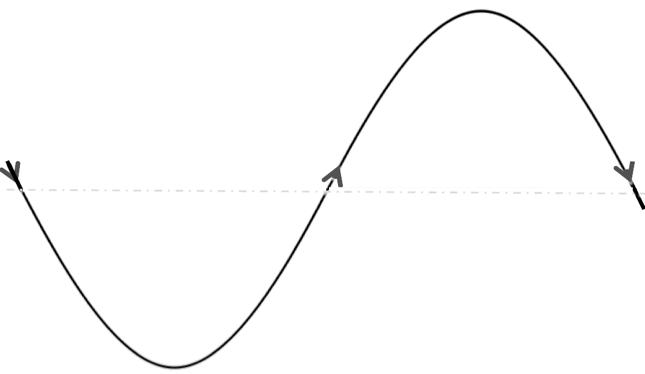
Feelings that have been inhibited bounce back to enable opJmal funcJoning and the realizaJon of full potenJal


TIME (in hours ideally)
SAFETY is key
ANXIETY - Gordon Neufeld Hirose Seminars - Calgary - May 9, 2024 Copyright 2024 Gordon Neufeld PhD 17
Sanctuaries for the Recovery of Feelings
shielding a%achments to caring adults
emoFonal playgrounds feelings




expressive


WHERE emotions like to PLAY




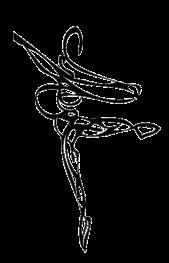




ANXIETY - Gordon Neufeld Hirose Seminars - Calgary - May 9, 2024
18
Copyright 2024 Gordon Neufeld PhD
NOT work NOT for real
PLAY
EmoQons are not at work, so the inhibiQon of feelings is reversed
Play is safe so feelings won’t get hurt
EmoQons are freer to move and so more likely to be felt and idenQfied
EmoQons are easier to feel when one step removed from real life
Words or their lack, do not get in the way
Feelings of fuQlity are much easier to access

Feelings are recovered when emotions are at play

ENCOUNTERS WITH FUTILITY



Sanctuaries for the Recovery of Feelings

a%achments to caring adults





emoFonal playgrounds



ANXIETY - Gordon Neufeld Hirose Seminars - Calgary - May 9, 2024 Copyright 2024 Gordon Neufeld PhD 19
WHY TODAY’S CHILDREN ARE MORE ALARMED and less able to deal with it
• premature separaJon
• failure to develop the capacity for relaJonship
• peer orientaJon
FACING MORE SEPARATION




BECOMING MORE ALPHA
LOSING THEIR FEELINGS
• failure of adults to inspire dependence
• not safe to depend
• peer orientaJon

• loss of the safe spaces for feelings to recover
• increased peer orientaJon and digital preoccupaJon
• increased drugs and medicaJons
ANXIETY
addressing the root causes of in children and adolescents
PART IV
ADDRESSING the ROOT CAUSES of all ALARM-BASED PROBLEMS including anxiety
reduce the separation they are facing
FACING MORE SEPARATION


BECOMING MORE ALPHA
LOSING THEIR FEELINGS
make it safe to feel
embed in cascading care
ANXIETY - Gordon Neufeld Hirose Seminars - Calgary - May 9, 2024 Copyright 2024 Gordon Neufeld PhD 20
ACTIONS & ACTIVITIES THAT PROVIDE MOMENTARY RELIEF - can develop into compulsions or addic2ons -



• triggering parasympatheQc acQon (eg, sucking, eaJng, chewing, nail-biJng, masturbaJon [boys], physical exerJon, controlled breathing)

proximity fixes (stroking, hugging, transiJonal objects, contact comfort)












rhythmic acQvity and pa]erning (rocking, pacing, rhythmic beat, drumming, swinging, worry beads, flickering fire, watching waves, hand wringing, etc )
through cauQon, sadness or courage


• drug-taking – depressants (eg - alcohol for alarm, marijuana for agitaJon, myriad of anJ-anxiety drugs & medicaJons)
• drug-taking – sQmulants to evoke a return swing of the pendulum – caffeine, nicoJne, Ritalin, etc

• emoQonal playgrounds where alarm is de-acJvated – eg, music, drama, art, dance, movement, stories, silliness, humour, games, cultural rituals the problem with conQnuously seeking temporary RELIEFis that it ignores the ROOTS of alarm and interferes with its natural RESOLUTION
Approaches that treat the child DIRECTLY and are NOT informed regarding ALARM or its purpose
BEHAVIOUR FOCUS
address behaviour problems stemming from being alarmed or defended against it – avoidance, agita2on, geIng into trouble, adrenalin-seeking
MEDICAL APPROACH
diagnose for mental illness and use medica2ons to counter the effects of alarm on the mind and body

REMEDIAL LEARNING
address learning problems stemming from the effect of alarm on a"en2on, mo2va2on curiosity, and performance


SKILL-BASED APPROACH
teach skills to calm the alarm – eg, self-regula2on, breathing, medita2ng, self-affirma2ons
COGNITIVE APPROACH
confront the irra2onality of alarm-fueled obsessions
MEDICAL APPROACH
COGNITIVE APPROACH
BEHAVIOUR FOCUS







PLAY-BASED intervenQons aimed at development and remediaQon, including restoring tender feelings




SKILL-BASED APPROACH
REMEDIAL LEARNING

alarm system dysfuncQon resulQng from lack of feelings RELATIONSHIPBASED intervenQons aimed at altering a]achments, reducing the separaQon faced, and restoring tender feelings
highly alarmed from facing separaQon


ANXIETY - Gordon Neufeld Hirose Seminars - Calgary - May 9, 2024 Copyright 2024 Gordon Neufeld PhD 21
EVIDENCE-BASED, POWERFUL and SAFE
INDIRECT and NON-INTRUSIVE
ADULT-FOCUSED – adults are the ones RESPONSIBLE
NATURAL and INTUITIVE (given supporJng insight)
RELATIONAL & PLAY-BASED intervenQons

UNIVERSAL in APPLICATION
do NOT require PROGRAMS for execuJon
do NOT require EXPERTS or specialized training
are NOT dependent upon medical DIAGNOSES or the construct of mental illness
The ulJmate challenge in addressing alarm problems is to REDUCE the SEPARATION being faced and RESTORE the FEELINGS of separaJon and alarm, to the point where the alarm system can more easily move the child …
… to CAUTION if that is possible
… to ‘CRY’ if that is fuJle

SYMPTOMS OF PRIMAL EMOTION

COGNITIONBASED DERIVATIVES OF PRIMAL EMOTION


ANXIETY phobias
COMPULSIONS worry FEAR tension panic self-doubt idenQty confusion restless AGITATION NERVOUS paranoia unease

PRIMAL EMOTION
… to take COURAGE if what alarms is in the way ALARM triggered by facing separation


OBSESSIONS mistaken assumpJons regarding what’s wrong

TRIGGERING EXPERIENCE feeling the feeling the




ANXIETY - Gordon Neufeld Hirose Seminars - Calgary - May 9, 2024 Copyright 2024 Gordon Neufeld PhD 22
GENERAL GUIDELINES
FOR ADDRESSING ALL ALARM-BASED PROBLEMS
Treat all as HIGHLY ALARMED, especially those not manifesting feelings of apprehension


COME ALONGSIDE –using the insight of ALARM to find one’s way to their side

NORMALIZE alarm, no matter how exotic or extreme the symptoms or pathologized by clinical diagnoses
- to develop, ac2vate and maintain a rela2onship as well as take the lead


toengagethe attachment instincts anythingthatcoulddivide
- to take the alarm out of a"achment, making it safe to a"ach



- to caring adults and emoFonal playgrounds in order to provide safe refuge from alarm and safe sanctuary for their feelings

When facing separation, preserve the connection by drawing attention to the next point of contact or to what stays the same.
ANXIETY - Gordon Neufeld Hirose Seminars - Calgary - May 9, 2024 Copyright 2024 Gordon Neufeld PhD 23
Embed in Cascading Care
• to ADDRESS peer orientaJon and alpha stuckness in order to reverse their impact on alarm
• to create a REFUGE as well as a safe place for feelings to BOUNCE BACK
• to EMPOWER adults to help culJvate a child’s relaJonship with alarm and resolve it via cauJon or sadness or courage

• to give adults more CONTROL over the wounding and alarming social interacJon between children
• to SHIELD a child against the impact of alarming interacJon
• taking care of younger children provides a suitable & non-alarming OUTLET for children’s own ALPHA insJncts
- hierarchical rela2onships with caring adults as well as younger children in need of their care and protec2on -
- by taking care of them in some way or another
- by coming alongside
- by having them on your radar
INVITE DEPENDENCE CONVEY CARING

- make it SAFE to depend
- provide SPACES for feelings to recover
assume a CARING ALPHA role and posture
ANSWER ATTACHMENT NEEDS
- inspire TRUST
- for sameness, belonging and significance - for an invita2on to exist in one’s presence - for a sense of togetherness that is not threatened

• SCRIPT cauJous behaviour when needed
• teach the LANGUAGE of alarm indirectly through reflecJve mirroring
• prime SADNESS if possible, indirectly and one step removed, if needed
• foster a RELATIONSHIP with ALARM, starJng with accepJng its inevitability
from a place of trusting dependence
• MODEL a healthy relaJonship with alarm including the opJons of cauJon, ‘crying’ and courage
• lead into MIXED FEELINGS if inner conflict exists
• serve as TRAFFIC DIRECTOR if you can, helping to a resoluJon that is most suitable to the situaJon
ANXIETY - Gordon Neufeld Hirose Seminars - Calgary - May 9, 2024 Copyright 2024 Gordon Neufeld PhD 24
Addressing ALARM through PLAY
• playfully alarming DEVELOPS the alarm system and BUILDS tolerance of alarm
• play provides temporary REST and RELIEF from alarm
• RE-PLAY of alarming scenarios can lead to eventual resoluQon


• alarm can be MASTERED in play
• play can provide SAFE DISCHARGE for alarm-fueled compulsions, agitaQon and adrenalin-seeking

• SADNESS is much easier accessed in the play mode
• play is the perfect scenario for the ‘DRAGON & TREASURE’ experience
• obsessions and compulsions can be DEFUSED in play
• ATTENTION problems are best addressed through play
PLAYING with ALARM
• peek-a-boo play
• startle play
• ambush games
• ‘falling’ play
• rescue play


• safe-at-home play
• safe hide-away play
• dare games

• monsters & scary creature play
• scary stories, games and acQviQes
Playing with facing separation
• GAMES
• TRAGIC STORIES

• MUSIC

facing separation
• POETRY & ART
• HUMOUR
• CULTURAL FESTIVALS
ANXIETY - Gordon Neufeld Hirose Seminars - Calgary - May 9, 2024 Copyright 2024 Gordon Neufeld PhD 25







Bringing obsessions and compulsions into play
When my son was younger, around 4 or 5, he developed rituals upon walking from room to room, from inside the car to outside and so on. He would walk one step forward and then back and then forward and then back again a certain number of 2mes. At some point I began taking his hand and “dancing” back and forth with him - which made him smile. AGer some 2me, I would lead him - get there first and eventually began to add new mo2ons to his “dance”. That turned it into a game and at some point, I’m not even sure when, this habit disappeared.
Play Holds the Most Promise
• PLAY is the best CONTEXT for the aTenJon system to develop, repair, or find ‘work-arounds’
• aTachment and alarm are at REST, allowing aTenJon some free Jme to play


• CURIOSITY is the best ANTIDOTE to any aTenJon problem, as it can pull the child through in their area of interest
immaturity -based hyper-sensitivitybased attachment -based ALARM -based

ATTENTION PROBLEMS





• defensive filters are SUSPENDED in the play mode, stopping the mixed messages in alarm-based aTenJon problems
• aTenJon is DRAWN rather than driven in play, allowing for opJmal funcJoning
• play facilitates prefrontal cortex development, resolving impulsiveness and MATURING the aTenJon system
ANXIETY - Gordon Neufeld Hirose Seminars - Calgary - May 9, 2024 Copyright 2024 Gordon Neufeld PhD 26
ADDRESSING THE ROOT CAUSES OF ALARM
USING RELATIONAL & PLAY-BASED INTERVENTIONS
reduce the separation they are facing
FACING MORE SEPARATION


LOSING THEIR FEELINGS
embed in cascading care
make it safe for children to feel
addressing the root causes of
ANXIETY
in children and adolescents
- an a%achment-based developmental approach -
Gordon Neufeld, Ph.D. Developmental & Clinical Psychologist Vancouver, Canada
ANXIETY - Gordon Neufeld Hirose Seminars - Calgary - May 9, 2024 Copyright 2024 Gordon Neufeld PhD 27
BECOMING MORE ALPHA



























































































































